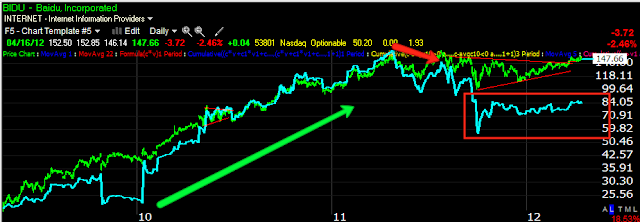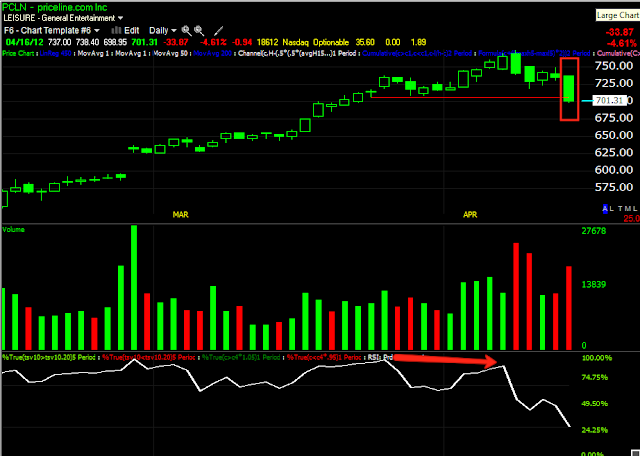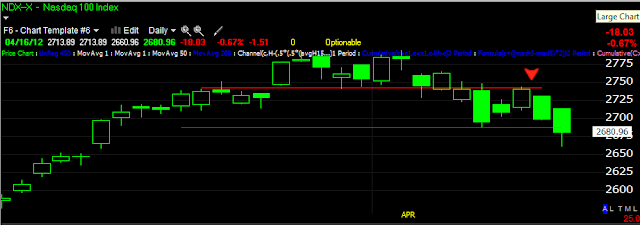I mentioned several times today that the $USD weakness that developed after the European close was broadly supportive of the market...
Here's an example using the EUR/USD which accounts for 50% of the Dollar Index
In red the Euro moves down, the dollar moves up which pressures the market and as you can see, the Dow slid at that point as would be expected. After the EU close the Euro gained strength and the Dow was roughly in line the rest of the day except the end when the Dow sold off a bit in to the close, even though the weaker dollar was still supportive of the market.
With Yields in Spain rising above 6% and Italy quickly approaching the same, Euro strength/Dollar weakness is a bit unexpected. There's a gaping hole in in EU banks' capital requirements, some such as Unicredit and Credit Agricole are falling way behind on what is acceptable capital requirements. In fact, as a percentage of their market cap, the two banks along with several others have about a 60% capital gap vs their market capitalization. On average throughout the EU banking system, the average is around 20% of market cap. With their share rices being where they are, these bans do not want to issue new shares and it's unlikely many investors will step up to purchase a new offering knowing that it is going to be used to fill a massive gaping hole in their capital structure.
You may recall in October, one of the things that pushed the rally in the market above and beyond where one would have expected was a massive liquidation of $US dollar denominated assets by EU banks as they had been ordered to recapitalize. During October, for the first time since Markit's inception of their PrimeX market funds (Prime mortgage backed indices), they fell below par, that was the first time ever and why? European banks were selling any and all assets that weren't nailed down to raise capital. The end result was the $USD denominated assets which the EU banks sold had to be repatriated back to the local currency, the Euro; this meant that once the $USD denominated asset was sold, the funds from that transaction (which were in $USD) had to be sold and Euros bought to bring the money back to the EU banks. Arbitrage algos which see dollar weakness as stock cheapness went on a buying spree pushing the market higher, the algos are Currency arbitrage programmed, the computers didn't know what the underlying situation was, they only saw $USD weakness and equated that (as they are programmed to do) with stocks being cheap and they did what they were programmed to do and bought equities. This was a confusing environment because the underlying cause causing the market to rise was a huge problem with EU bank capital, which would normally be associated with a market negative event, however the sale of $USD's pushing the $USD lower and subsequent purchase of Euros pushing the Euro higher created a self-fulfilling loop that the algos had no way of understanding. The end result was a risk on environment in stocks during a market negative event all because $USD denominated assets had to be repatriated to EU banks to plug the liquidity holes.
Since then the ECB (European Central Bank) has conducted two LTRO's in which banks can pledge assets to the ECB and receive a 3 year loan at 1% interest. This money was "intended" to be used by banks to finance a carry trade by buying their county's sovereign debt, thus driving yields down. Very few banks actually conducted this carry trade (it's a 3 year carry trade in theory because the banks get the ECB loan at 1% and then buy higher yielding sovereign debt at 4-6%, the difference between the yield and the interest rate paid on the loan is their carry trade profit).
Instead most bans put the money directly in to the ECB's deposit facility which set new all time records after each of the ECB's L 2 LTRO operations, in reality the banks would rather have the money on deposit with the ECB at a .75% interest rate and lose .25% (being the loan cost 1%) then to invest in sovereign debt. There have been examples of banks buying sovereign debt, we know this because the debt auctions by various PIIGS countries are generally successful if the maturity of the debt is shorter than 3 years, but when the debt being issued is longer than 3 years, the auctions tend to fail. The problem for EU banks now is that they have pledged the majority of collateral to get the LTRO loans and are now left with little left to secure funding. Sovereign yields are rising again, this is not good for the Euro, yet the Euro defended $1.30 and lifted today. This suggests that EU banks may once again be selling $USD denominated assets in an attempt to bring liquidity back home, not necessarily capital. Anyone who has run a business understands that cash flow is not the same as profit, yet these banks must raise liquidity as sources of funding are drying up.
If I had to venture a guess, by looking at the breadth of the market, I'd guess that they've been selling equities in the U.S. markets and converting the $USDs to Euros if this is in fact what is happening again. It is clear the EU banks desperately need liquidity and capital. We may in fact be seeing a similar situation, however this time it may play out a bit differently as algos are less likely to be engaging in currency arbitrage, although there are certainly a portion that do nothing but that.
If this were to come together with increased volatility, the bounce we get could be the bounce I was expecting (at least a break above the support that has been broken in the market). As this seems to be a rather new event its difficult to say if this is what is happening, but it should be monitored. Should the EUR keep rising with sovereign yields spreading wider, then there's probably some repatriation of Euros going on. Whether the market (more specifically algos) are willing to chase it as aggressively as last time is doubtful in my mind, but it may provide a little boost needed to get above those broken support areas on the original volatility shakeout move.
The European markets are clearly rolling over as seen here in the Euro Top 100 Index.
Here's the EUR/USD opening Sunday night in green, the market open today in yellow and the close in red.
The trajectory of the Euro today, this means the $USD fell
Here's the SPX/Euro correlation today, in this case the Euro is more supportive than the SPX moved today (white).
The $AUD didn't see the same rise as the Euro did, this would suggest that the other currencies vs the dollar are not reacting, which would suggest the Euro/$USD is the pair that is reacting. In an environment of rising EU sovereign debt yields, this would not normally be expected unless there was a basic supply demand issue, one of selling $USD and buying $EUR to increase EU banks' liquidity. This would also have another effect, it would remove support for stocks as the stocks would first have to be sold before any currency repatriation could take place, further undercutting the breadth of the market and making it more of a house of cards than it already is.
I'm not jumping to any conclusions as of yet, but this is something worth understanding and monitoring.
As of now the Euro is pretty flat since the close, ES is also flat since the 4 p.m. close.
I'll update any changes.
Is interest rates about to start going up?
-
Yes, I know - it does not make any sense - FED is about to cut
rates...but....real world interest rates are not always what FED wants it
to be.
6 years ago
























































